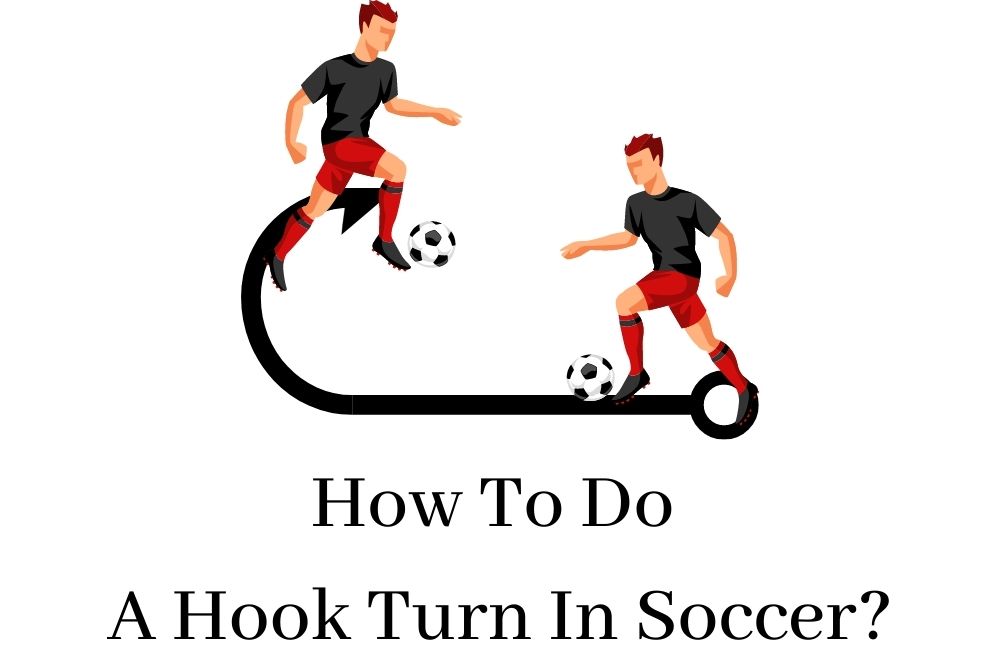There are many fun and competitive sports in the world but soccer ranks top on the list. It has a spectacular blend of tremendous skills, splendid team play, and individual creativity. It is sometimes referred to as “the great game.”
If you intend to become a professional soccer player, you need to, first of all, study the fundamental rules and regulations guiding the numerous skills and techniques practiced in the sport.
Maintaining ball control on the pitch requires you to keep balls at your feet at all times. The hook turn is one of the techniques for constantly keeping the ball at your feet.
In soccer, the hook turn is a fundamental technique that all players should be familiar with. It allows players to swiftly reverse directions with the ball and flee from an opponent’s marking.
We will show you how to properly execute the hook turn, both the inside and outside hook turns, and why hook turns are useful on the pitch during matches. We will also list important points to note while learning how to do the hook turn.
Quick Navigation
How to do a hook turn in soccer?
Without any doubt, every soccer player aspires to be special, to organize their talents, and to display great skill on the pitch. The hook turn is one of the fundamental skills a player can learn to stand out during matches.
Elite soccer players always do the hook turn during soccer games. For instance, Megan Rapinoe of the United States was outstanding as she performed multiple hook turns during the round of 16 women’s World Cup games between the United States and Spain, at Stade Auguste-Delaune in Reims, France.
Many soccer players have equipped themselves with this fundamental skill which they often use during matches to their advantage. Before we advance into teaching you how to do a hook turn, we need to, first of all, explain to you what a hook turn is.
A hook turn is a move used by players to change direction by “hooking” the ball with their foot. Hooking the ball requires turning the foot and drawing the toes up, this enables the foot to hook or chop the ball, causing it to reverse direction.
Note that different individuals use numerous phrases in different regions of the world to describe the hook turn. Some soccer spectators call it a “cut” while others call it a “cutback” even though it is officially known as a “hook turn”.
It is also vital to understand that these names are occasionally used interchangeably for different reasons and better understanding. Some people explain the hook turn as using the foot to change the direction of the ball by performing a 180-degree turn.
And the phrase “cut” may refer to utilizing the foot to hook the ball to the left or right in a 90-degree rotation. Regardless, a hook turn in soccer is a skill that has two versions.
A player can “hook” the ball with the outside or inside of his or her foot to swiftly change its direction. An “inside hook” is a hook turn that uses the inside of the foot, and an “outside hook” uses the outer part of the foot.
How to do an inside hook turn in soccer?

An “inside hook turn” is a soccer strategy where a player hooks the ball with the inside of their foot and moves in the opposite direction. When a player needs to quickly move away from an opponent, he or she can employ an inside hook.
To perform an inside hook turn, a player is required to put their body in between the ball and the opponent. The player can then hook the ball with the inside of their foot, causing it to travel in the opposite direction.
The player can then dribble with both the inside and outside of their boot. The step-by-step instructions for doing an inside hook turn are provided below.
Step 1: Safeguard the ball
Whenever an opponent player is sprinting alongside you, ensure you shield the opponent from the ball. You can easily shield an opponent from the ball using your arm and shoulder but please avoid using your elbow.
You will find it very difficult to perform an inside hook turn properly if you don’t shield the ball from your opponent. When doing the hook turn with the inside of the right foot, right-footed players should keep the opponent to their right.
On the other hand, left-footed players should keep the opponent to their left if they are doing the hook turn with the inside of their left foot.
Step 2: Slow down
Slow the ball down gradually and steadily. When you steadily slow down the ball, you will have better control over it.
If you are being marked by an opponent, use calculated arm movements to further assist you in keeping the opponent at bay. Before trying to do the hook turn, make sure the ball is fully in front of you.
When you are under pressure, don’t slow down unduly or you will risk losing the ball to your opponent. You also run the risk of falling and injuring yourself.
The hook turn is not a skill you would want to use in getting past an opponent or to attack them swiftly. It is most effective in switching the direction of play, for example, from the right to the left-wing.
Step 3: Fake a movement
It is smart and advantageous to confuse your opponent by giving them a false direction or creating a false impression to have more space and time to do an effective inside hook turn.
All you have to do is to fake a movement with your legs to create the impression that you are about to make a move like shooting, passing, or changing direction.
Step 4: Do the turn
To do the hook turn, move your body slightly ahead of the ball, approximately a foot away. Then, put your standing foot firmly near the ball to act as a pivot throughout the turn.
If you intend to hook the ball with your right foot, it is best to place your left foot firmly on the ground near the ball. If you’re going to hook the ball with your left foot, the standing foot should be your right.
Get the other foot, the non-standing foot, behind the ball and keep it outstretched. Cut the ball behind it or use the inside of the extended foot to hook it.
While hooking the ball from behind, pivot the planted foot at a comfortable angle and turn. It is all about shifting the focus on the ball away from the defenders.
Rotate in the direction you would want the opponent to follow and then in a split second, turn entirely differently in the opposite direction. Usually, the turn is 180 degrees.
Remember to apply the principle from Step 1 here as well. Shield the ball away from your opponent while performing the turn by positioning yourself properly.
For a successful turn, establish an athletic pose by bending your knees and lowering your hips while doing the turn.
Step 5: Drive away with the ball
After changing directions, give the ball a good first touch and speed off. You may use your feet to rapidly drive the ball, make a pass, or continue dribbling.
Even though this skill is simple to learn and perform, it must be accompanied by a follow-up move that allows you to completely evade an opponent.
How to do an outside hook turn?
In soccer, an outside hook turn is a technique whereby players use the outside of their foot to “hook” the ball and advance in other directions. An outside hook is a good way to delude an oncoming opponent.
The procedures for performing an outside hook turn in soccer are identical to those for doing an inside or inner hook turn, but with a few exceptions. The steps for doing an outside hook turn are shown below.

Step 1: Safeguard the ball
Maintain possession of the ball while keeping your opponents at bay. When sprinting alongside opponents, you should always be between them and the ball—even if you’re in a side-by-side race.
Left-footed players should keep the opponent to their right since they will utilize their left foot to do the hook turn. Right-footed players, on the other hand, must keep the opponent to their left when performing the hook turn with the outside of their right foot.
Step 2: Slow down
Slow down gradually so you don’t lose control of the ball. Use well-calculated arm movements to keep your opponent at a safe distance. Wrong arm movements can get you penalized or even injured.
Step 3: Fake a movement
Although it is not necessary, it is useful to fool your opponent by giving them a false direction or creating a false impression.
Pretend a movement in a false direction with any part of your body to create the idea that you are about to take a shot or pass the ball.
Step 4: Do the turn
Move your body slightly ahead of the ball by roughly a foot and place your standing foot solidly beside it.
If you intend to hook the ball with your right foot, it is best to place your left foot firmly on the ground near to the ball. If, on the other hand, you want to hook the ball with your left foot, the standing foot must be your right.
Stretch the other foot that isn’t planted behind the ball. Cut the ball behind it or use the outside of the extended foot to hook it.
Hook the ball from the rear, then twist the planted foot through an angle and turn fully. Turn entirely in the direction you came from, or in another direction.
Shield the ball away from your opponent when you turn by positioning yourself between the ball and your opponent. Use your arms to achieve more balance and keep your opponent at bay.
Step 5: Drive away with the ball
Dribble away after hooking the ball and changing direction. Push the ball away rapidly, then do the subsequent moves as it pleases you.
What are the benefits of the hook turn?
- A hook turn is an excellent skill to use when evading an opponent’s pressure and preventing them from man-marking
- When players are in the final third of the field and attacking the penalty area, or when they are crowded in on a wing and want to shift direction away from the sidelines, the hook turn is an excellent option
- A hook turn allows a player to effectively switch the direction of the ball
- Players can employ this skill when sprinting towards the goal area or the sideline and need to turn or beat an opponent
- This is an excellent technique that can be used when attacking the penalty area with defenders beside or in front of you and you need to change direction
- The hook turn can also be used to keep the ball from going out and causing a corner kick or throwing to the opponents’ advantage

Training tips for a hook turn
At the initial stage of learning to do a hook turn, players, especially young ones usually struggle to keep their balance when turning. When learning hook turns, we advise students to focus on skills rather than speed.
- HIGH QUALITY SPORT CONES - Do you need something that will help you to train anytime and anywhere...
- BRIGHT AND VISIBLE COLORS - Keep the fun going with this amazing soccer accessories set having HIGH...
- JUST THE RIGHT AGILITY TRAINING EQUIPMENT - Created especially for all devoted players who like to...
Last update on 2023-11-11 / Affiliate links / Images from Amazon Product Advertising API
Set up two or more cones in different locations and experiment with them. Running towards the cones and making the hook turn around them is a good way to practice it.
Also, practice with other teammates who can stand in as the opponents. Keep the following tips in mind as you practice the hook turn.
- As you approach the cone where you will finally make the turn, slow down
- Keep your body between the ball and the defender to shield it
- As you turn, use your arms to keep your balance
- After you’ve completed the turn, run as fast as you can, away from the opponent

Conclusion
One of the major aims of soccer games is to keep possession of the ball while evading opponents. To do so efficiently, soccer players must understand how to apply the hook turn on the field.
This method allows players to reverse or shift the direction of the soccer ball to avoid immense pressure from opponents. If you are a young soccer player, the hook turn may be tough to learn but you mustn’t be discouraged.
Spend some time learning about its basic concepts and continuously practice the steps as shown in the article. Keep training and celebrating your progress and you will never regret learning this skill.
Hi there, I’m Jay.
Soccer is everything in my life! My friends and I have created this blog with all our enthusiasm, passion, and understanding after years of playing pro soccer. Hope you will enjoy it!

